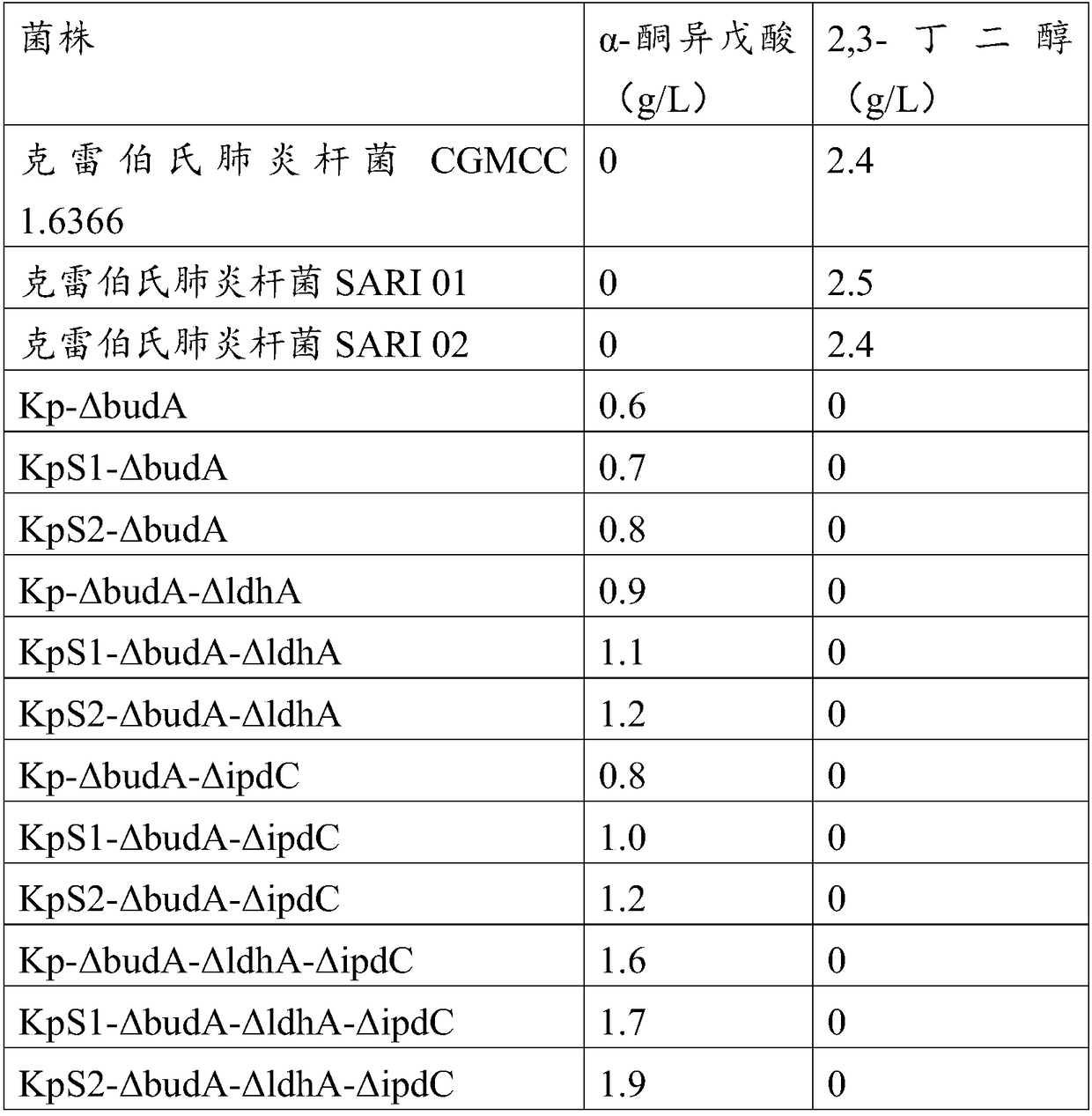Method for improving alpha-ketoisovaleric acid yield of Klebsiella pneumoniae, and modified strain
A technology of pneumonia bacillus and ketoisovaleric acid, applied in the field of bioengineering, can solve problems such as undiscovered, and achieve the effects of wide range of raw materials, high final product concentration and high genetic stability
- Summary
- Abstract
- Description
- Claims
- Application Information
AI Technical Summary
Problems solved by technology
Method used
Image
Examples
Embodiment 1
[0021] The gene recombination method is used to inactivate the acetolactate decarboxylase gene of Klebsiella pneumoniae CGMCC 1.6366 (the strain is also called TUAC01, AC01) to achieve the inactivation of acetolactate decarboxylase activity.
[0022] The strain of Klebsiella pneumoniae CGMCC 1.6366 has been disclosed in the open literature (Wei Dong, Wang Min, Shi Jiping, Hao Jian.Red recombinase assisted gene replacement in Klebsiellapneumoniae.Journal of Industrial Microbiology&Biotechnology.2012 39:1219-1226) Strains. This strain is a strain used to produce 1,3-propanediol, 2,3-butanediol, acetoin and 2-ketogluconic acid. The bacteria was isolated from the soil, and the isolation and characterization of microorganisms able to produce 1,3-propanediol underaerobic conditions. World Journal of Microbiology Biotechnology 2008, 24: 1731-1740 are described in the literature (Hao Jian, et al. Isolation and characterization of microorganisms able to produce).
[0023] 1) The acetolacta...
Embodiment 2
[0043] The gene recombination method was used to construct Klebsiella pneumoniae in which the acetolactate decarboxylase gene and the lactate dehydrogenase gene were simultaneously inactivated to achieve the simultaneous inactivation of the acetolactate decarboxylase and lactate dehydrogenase activities.
[0044] 1) Amplify the lactic dehydrogenase gene sequence of Klebsiella pneumoniae by PCR, connect it to the cloning vector by the TA cloning method, and perform DNA sequence determination.
[0045] According to the genomic information of Klebsiella pneumoniae 342, PCR primers for lactate dehydrogenase gene were designed, the upstream primer ldhA-s: AGAGCGCACAGGACCACTATCCA (shown in SEQ ID NO. 11), and the downstream primer ldhA-a: TCGGCGAGCTTATAGACCAGCGT (SEQ ID NO. 12) Shown).
[0046] Using the above primers and using Klebsiella pneumoniae CGMCC 1.6366 genomic DNA as a template, the lactate dehydrogenase gene and adjacent fragments were obtained by PCR amplification, and ligated ...
Embodiment 3
[0063] The gene recombination method was used to construct Klebsiella pneumoniae in which the acetolactate decarboxylase gene and the indole-3-pyruvate decarboxylase gene were simultaneously inactivated to realize the simultaneous activity of acetolactate decarboxylase and indole-3-pyruvate decarboxylase Inactivated.
[0064] 1) The Klebsiella pneumoniae indole-3-pyruvate gene sequence was amplified by PCR, connected to the cloning vector by the TA cloning method, and the DNA sequence was determined.
[0065] According to the genomic information of Klebsiella pneumoniae 342, PCR primers for the indole-3-pyruvate gene were designed. The upstream primer ipdC-s: GCATAGAGCCCATCTCCTGAATCGT (SEQ ID NO. 16), the downstream primer ipdC-a: ACACCGCCTTTATCACCCCCTTTCT (SEQ ID Shown in NO.17).
[0066] Using the above primers and using Klebsiella pneumoniae CGMCC 1.6366 genomic DNA as a template, PCR amplification was performed to obtain the pyruvate decarboxylase gene and adjacent fragments, wh...
PUM
 Login to View More
Login to View More Abstract
Description
Claims
Application Information
 Login to View More
Login to View More - R&D
- Intellectual Property
- Life Sciences
- Materials
- Tech Scout
- Unparalleled Data Quality
- Higher Quality Content
- 60% Fewer Hallucinations
Browse by: Latest US Patents, China's latest patents, Technical Efficacy Thesaurus, Application Domain, Technology Topic, Popular Technical Reports.
© 2025 PatSnap. All rights reserved.Legal|Privacy policy|Modern Slavery Act Transparency Statement|Sitemap|About US| Contact US: help@patsnap.com



